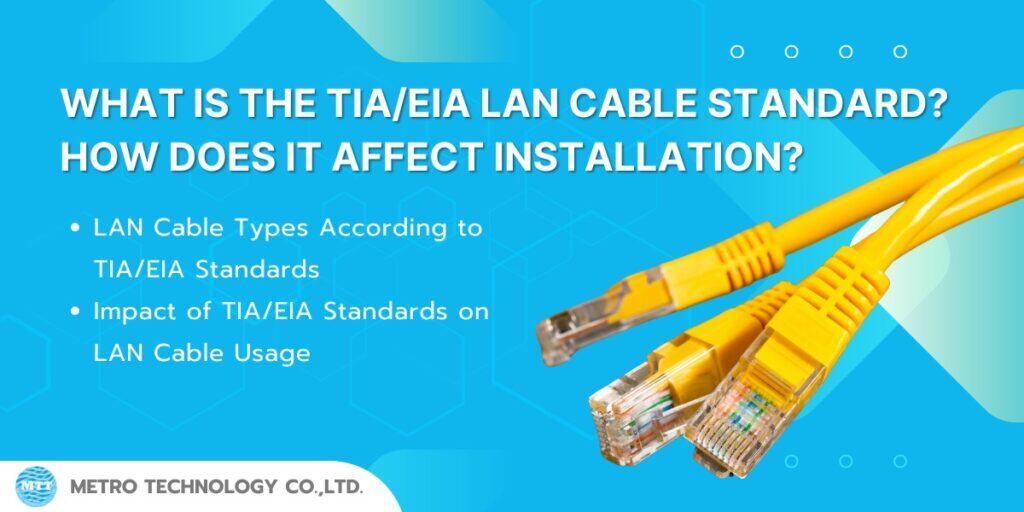What is a TIA/EIA LAN Cable?
A TIA/EIA LAN cable refers to a cable that is designed and manufactured according to the standards set by the Telecommunications Industry Association (TIA) and the Electronic Industries Alliance (EIA). These standards define the requirements for the installation and operation of telecommunication network systems, including the cables used in Local Area Networks (LANs).
Overview of TIA/EIA LAN Cable Standards
The TIA/EIA standards are a set of guidelines specifying requirements and best practices for the installation and operation of telecommunications and network cabling systems, especially for LAN cabling. These standards address cable characteristics, installation practices, and performance testing. They are widely adopted to ensure high performance and stability of network systems by defining aspects such as:
- Data transmission speed
- Interference protection
- Installation and testing procedures
LAN Cable Types According to TIA/EIA Standards
The TIA/EIA standards outline the characteristics and usage of LAN cables to ensure efficient, reliable, and secure computer networking. Key standards include:
- TIA/EIA-568: The primary standard that defines installation, types of LAN cables (e.g., Cat5e, Cat6, Cat6A, Cat8), and performance testing requirements.
- TIA/EIA-569: Covers the design of pathways and spaces for LAN cabling within buildings.
- TIA/EIA-606: Specifies labeling and identification methods for cables to simplify management and maintenance.
Impact of TIA/EIA Standards on LAN Cable Usage
- Ensure network installation is stable and supports high data rates
- Reduce interference issues such as crosstalk and data loss
- Allow easy expansion and upgrades of LAN systems in the future
- Support accurate cable testing and quality verification
Using TIA/EIA-compliant LAN cables ensures high-quality, high-performance networks with long-term reliability. It also simplifies installation and maintenance, while providing flexibility for future upgrades.
ANSI/TIA-568 Standard for LAN Cabling
Developed by the American National Standards Institute (ANSI) in collaboration with the EIA and TIA, this standard outlines the requirements for commercial building cabling to support telecommunications products and services. It aims to create a reliable and internationally recognized infrastructure, especially for LAN systems using UTP (Unshielded Twisted Pair), STP (Shielded Twisted Pair), and fiber optics.
Key Elements of the ANSI/TIA-568 Standard
- Cable Categories: UTP cables are categorized based on data transmission capability: Cat 3, 4, 5, 5e, 6, 7, etc.
- Impedance: 100 Ohms ±15% for optimal signal performance
- Attenuation: Signal loss measured in decibels (dB)
- NEXT & PS-NEXT: Measures near-end crosstalk between transmitting and receiving wires
- ELFEXT & PS-ELFEXT: Measures far-end crosstalk and its combined effect
- Return Loss: Measures the amount of signal reflection in the cable
- Maximum Cable Length: Should not exceed 100 meters, including patch panels
- Topology: Star topology is recommended for effective system management
Use Cases
ANSI/TIA-568 is essential for building reliable telecommunication systems in offices, commercial buildings, and data centers. It is commonly applied in LAN cable installations.
Cable Testing
After installation, cables must be tested to ensure compliance using a Cable Analyzer. Tests include continuity, wire mapping, crossovers, and other parameters defined by the standard.
ANSI/TIA-568.3-E Standard for Fiber Optic Cabling
Published in September 2022 by the TIA and certified by ANSI, this standard outlines requirements for fiber optic performance, transmission, and testing. It covers:
- Purpose: Ensures quality and performance of fiber optic cables, connectors, hardware, and patch cords
- Key Updates:
- OM1 and OM2 cable colors removed
- Reference signal loss changed to 0.5 dB for multimode fiber
- Connector colors moved to an appendix
- New OS1a category added
- Duplex polarity management methods introduced (e.g., LC-to-LC positioning)
This standard ensures high-performance fiber optic installations in real-world scenarios.
Are ANSI/TIA-568 and TIA/EIA-568 the Same?
Yes and no.
While both refer to the same set of standards, TIA/EIA-568 is the older name. Originally developed jointly by the TIA and the now-defunct EIA, the standard is now maintained solely by the TIA and is officially referred to as ANSI/TIA-568.
So, the content and objectives remain the same, but the name reflects the current organizational structure.
.
If you need to rent network testing equipment or require installation services, feel free to inquire for more information at Metro Technology Co., Ltd. or click here to contact us.



